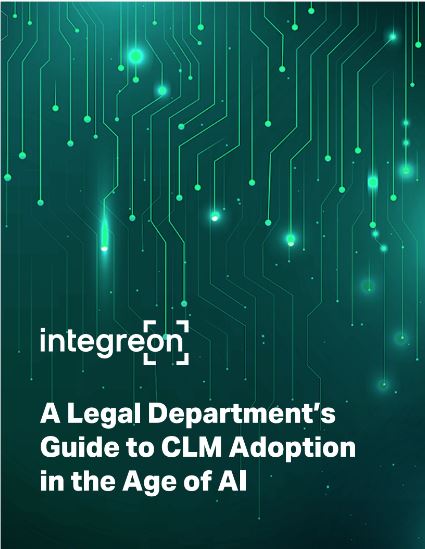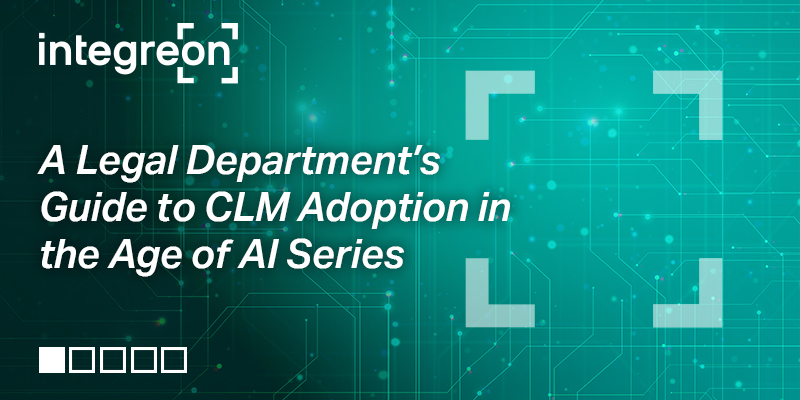This is the first blog of a five-part series on CLM Adoption in the Age of AI.
Contract lifecycle management (CLM) technology is critical to today’s legal operations. Already well established as tools to drive efficiency, many CLM solutions now deliver even greater value by incorporating generative AI capabilities.
The CLM Tech Boom
Contract lifecycle management (CLM) technology was originally designed to address the efficiency challenges associated with manual contract management. By automating various stages of the process, CLM tools helped to eliminate administrative bottlenecks, drive accuracy, and optimize processes for speed. The move to cloud-based platforms over the last decade spurred a significant era of innovation. Existing CLM tools evolved, and new ones emerged, incorporating functionality like AI and analytics, compliance tracking, and integration with other backend systems like CRM and ERP.
Cloud spurred adoption as well, making CLM technology more widely accessible, cost effective, and scalable. Today 62% of organizations have a CLM solution in place, according to the 2025 CLOC State of the Industry Report.
Now, with advancements in generative AI (genAI), CLM technology is quickly evolving once again. The continuing search for ways to save time and costs make genAI-enabled CLM technology attractive: some companies have seen up to 50%+ productivity gain on the contract migration phase alone using CLM tools with AI. Today’s providers are going beyond efficiency and promising AI-powered insights that accelerate business growth.
Businesses are anxious to put this new technology into action. Just over half (54%) of the CLOC report respondents plan to implement AI within the next one to two years. However, stakeholders are doing their due diligence when it comes to software vendors. McKinsey predicts that one of the biggest impacts of generative AI will be the acceleration of vendor switching, up 5-10 percentage points.
Generative AI’s Impact on CLM Solutions
Generative AI significantly changes how businesses approach CLM technology. There are no best practices – yet. With this dynamic technology, innovation is a moving target. This makes choosing CLM solutions providers – and deciding which functionality to implement – more difficult.
As a whole, generative AI is just beginning to integrate across the contracting lifecycle, from pre- to post-execution. Your potential CLM provider may be providing only one or two generative AI-enabled capabilities today. Look for vendors with a well thought-out roadmap that shows future innovation.
Here are some examples of where generative AI increasingly has the potential to streamline and create greater accuracy for key phases of CLM:
Metadata abstraction
Instead of manually entering key information (like payment terms, deadlines, or parties involved), generative AI automatically extracts these data points from uploaded contracts and populates them within the system.
Review and redlining
Traditional CLM platforms rely on pre-configured clause libraries for drafting and reviewing. Generative AI eliminates this dependency by analyzing legacy contracts, creating a repository of fallback clauses, and suggesting replacements or edits during the review process.
Clause libraries
Generative AI can build a clause library dynamically in real time. When drafting or reviewing contracts, users can pick clauses and fallback options directly informed by historical patterns.
Language support
Generative AI solutions now support processing contracts in up to six or seven languages. This helps global organizations efficiently manage multilingual agreements without the burden of translation efforts.
Search and query
Some advanced CLM platforms are embedding AI-powered search capabilities through integration with platforms like ChatGPT. Users can query systems for specific contract-related information, and the AI pulls relevant clauses, obligations, or details instantly.
If you are interested in learning more about how you can effectively evaluate, adopt, and optimize CLM technology in 2025, especially given the new dimension genAI creates for this class of legal tech, then download our eBook, “A Legal Department’s Guide to CLM Adoption in the Age of AI.”
In this guide, we aim to provide some new parameters for how businesses evaluate, adopt, and optimize their CLM tools, especially given the expanded use of generative AI. From the latest advancements to practical implementation strategies, we will share insights to help you make the best decisions when it comes to your CLM technology strategy today – and unlock the power of your legal data. Download it today.

This 8-page guide covers:
- Understanding Generative AI (genAI) in CLM Solutions
- Internal Considerations for CLM Technology
- CLM Vendor Selection Considerations
- Getting the Most Out of your CLM Solution
- Gaining Momentum: Tech as a Service


